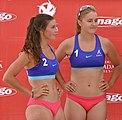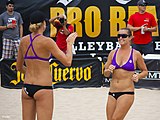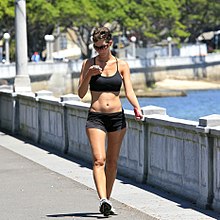Sports bra


A sports bra is a bra that provides support to a person’s breasts during physical exercise. Sturdier than typical bras, they minimize breast movement and alleviate discomfort.[1] Many people wear sports bras to reduce pain and physical discomfort caused by breast movement during exercise. Some sports bras are designed to be worn as outerwear during exercise such as jogging. There are also sports bras with extra padding for exercises that involve some kind of trauma to the breasts.[1]
History[]

The first commercially available sports bra was the "Free Swing Tennis Bra" introduced by Glamorise Foundations, Inc. in 1975. The first general exercise bra, initially called a "jockbra", was invented in 1977 by Lisa Lindahl and theater costume designer Polly Smith with the help of Smith's assistant, Hinda Schreiber. Both Lindahl and her sister, Victoria Woodrow, complained about their bad experience exercising in ordinary bras, having experienced runaway straps, chafing and sore breasts. During the course of Lindahl and Smith's exploration for a better alternative, it was suggested that what they needed was a jockstrap for women's breasts.[2] In the costume shop of Royall Tyler Theatre at the University of Vermont, Lindahl and Smith actually sewed two jockstraps together and nicknamed it a "jockbra". It was later renamed a "jogbra".[2] One of their original Jogbras is bronzed and on display near the costume shop of the theatre. Two others are housed by the Smithsonian and another by the New York Metropolitan Museum of Art.[3]
In 1990, Playtex purchased Jogbra from Lindahl and her partners. This was followed by research by , associate professor of surgery at the University of Medicine and Dentistry of New Jersey. She measured breast movement of women running on treadmills. Sought out by bra manufacturers for her expertise, she advocated wide bottom bands for extra support and firm straps that minimized breasts bounce. Renelle Braaten, a Montana hairdresser, struggled to contain her DD-sized breasts while playing racquetball and volleyball. Unable to interest mainstream bra manufacturers, she collaborated with freelance apparel designer Heidi Fisk, and founded Enell Incorporated. After considerable lobbying, she persuaded Oprah Winfrey in 2001 to try her bra. This led to very positive reviews in O: The Oprah Magazine, a 2001 appearance on The Oprah Winfrey Show, and a huge surge in orders.[4]
In 1999, at the 1999 FIFA Women's World Cup Final in Pasadena, California, after scoring the fifth kick in the penalty shootout to give the United States the win over China in the final game, Brandi Chastain celebrated by spontaneously taking off her jersey and falling to her knees in a sports bra. The image is considered as an iconic photographs of a woman celebrating an athletic victory. It was the first time ever that an international woman footballer exposed her sports bra by removing her top.[5][6]
Design challenges[]
Sports bras can either encapsulate or compress breasts. Bras that encapsulate breasts have molded cups designed to fit around each breast. Bras that compress are designed to restrict movement by holding the breasts firmly against the body. Encapsulation-type bras are generally more effective at reducing discomfort, while compression bras may be more effective for high-intensity activities.
The most common sports bra is basically designed like a tank top with the bottom half cut off. Other designs use gel and water pads, silver fibres, and air bags. A stitchless bra was made by Wacoal, was molded, compressed, and shaped. A compressed bra is designed to push the breasts against the chest to reduce movement and bounce. Other bras are knitted in circular patterns, giving varying stretch and support.[7] A common design uses a stretchable, absorbent fabric such as Lycra designed to reduce irritation by drawing perspiration away from the skin.
Sports bras are also worn by women after certain surgical procedures. In those situations, a front-closing sports bra with a compression, seamless cup is recommended for healing and comfort. Certain fabrics such as Lycra have been found to help reduce swelling and help "even-out" a bustline that has been altered by a surgical procedure.
Sports bras are also manufactured for men with large breasts to enable them to take part more comfortably in physical activity. Some descriptions used euphemistically to describe bras for men are chest binders, compression vests or shimmels.[8]
Problems arise from the shoulder straps of standard bras. Standard well-fitting bras are constructed in the form of a "square frame", with all dimensions adjusted for each woman in a normal standing position, with arms to the sides. When a woman performs an activity which requires her to lift her arms above the shoulders, the frame is strained because it is anchored by the chest band, putting direct pressure on the shoulder trapezius muscles. This may result in neck and shoulder pain, numbness and tingling in the arm and headaches.[9][10] To avoid such problems the bra's shoulder straps are usually crossed at the back, or the bra is worn halter-style.
Images of different designs[]

Front and side view of sports-bras worn by two beach volleyball players.

Back-view of sports-bra: Two strings coming from the horizontal strap join at the top.

Back-view of sports-bra: Bra shaped like a vest, it is without strings.

The woman on the left is wearing a sports bra whose horizontal strap is as thin as its supporting strings.
Levels of control[]
Different physical activities require different levels of breast control. Yoga, walking and gardening require only "light" control; bicycling, power walking and hiking require "moderate" control; tennis, soccer and jogging requires "firm" control; and running, intense workouts, boxing and horseback riding requires "maximum" control.
Some female athletes are concerned that a sports bra may interfere with breathing, but even though increased pressure on the rib cage has been demonstrated, no significant effect on breathing can be shown.[11]
Exercise discomfort[]
About 50 percent of women report some pain or discomfort in their breasts during exercise. This varies considerably in intensity and may depend on what they are wearing. In an Australian study, three women (aged 17–21, cup sizes B and C) were photographed exercising bare breasted, wearing two different bra models, and while wearing a specific sports bra. As expected, breast motion was reduced by bras, and the sports bra was the most effective. The women reported less discomfort with bras and especially with the sports bra. However, not all sports bras are created equally and a woman should be properly fitted.[12][13]

During 2007, scientist Doctor Joanna Scurr of the University of Portsmouth conducted a motion study of seventy women while running. They represented the widest range of breast sizes ever studied, from A up to JJ. Glamour model Jordan, whose bra cup size is F, is six cup sizes smaller than Scurr's biggest breasted subject.[14] Scurr found that breasts move in three planes of motion during exercise - vertically, horizontally, and laterally, in an overall figure-8 motion. Unrestrained movement of large breasts may contribute to sagging over time.[15] Motion studies have revealed that when a woman runs, more than 50% of the breast's total movement is vertical, 22% side-to-side, and 27% in-and-out.[16] The 2007 study found that encapsulation-type sports bras, in which each cup is separately molded, are more effective than compression-type bras, which press the breasts close to the body, at reducing total breast motion during exercise. Encapsulation bras reduce motion in two of the three planes, while compression bras reduce motion in only one plane.[14] Previously, it was commonly believed that a woman with small to medium-size breasts benefited most from a compression-type sports bra, and women with larger breasts need an encapsulation-type sports bra.[16] Scurr's research has shown that this is not true.
In 2010 Scurr, White and Hedger conducted a second study on the effect of breast support on the movement of the breast during the running gait cycle. The aim of this study was to investigate the multi-directional breast displacement, velocity, and acceleration with and without breast support during running and also to establish the correlation with breast comfort. Fifteen women who wore D cup sized bras and regularly participated in exercise took part. Using treadmill running in three different bra conditions (no bra, T-shirt bra, and sports bra), they concluded that breast displacement and velocity were reduced as breast support increased and that no particular direction of breast movement showed a stronger relationship to breast pain. Further to this they found that breast discomfort was most closely correlated to breast velocity.[17]
A third study in 2011 by Scurr and others looked at supported and unsupported breast displacement with the aim to quantify multi-directional breast displacement across varying activity levels and in varying breast support conditions. The study included 21 women who wore D cup sized bras. Their activity levels varied from treadmill walking to maximal treadmill running. Maximum displacement was found in the right breast during the unsupported condition at 15 km/h (9.3 mph), this showed an overall displacement of 15.8 cm (6.2 in). Results also showed that breast displacement was reduced as breast support increased by up to 59% in an encapsulation bra versus no bra. Results also showed that there was a significant increase in breast displacement as treadmill speed increased up to 10 km/h (6.2 mph). The results of this study concluded that at higher speeds of activity, vertical breast displacement was highest, however side-to-side and forwards-backwards movement still accounted for half of the total breast displacement. Therefore, this means that sports bra design should primarily concentrate on vertical displacement factors but not totally ignore other planes of motion. As no evidence was found that breast support requirements change as running speed increased, the study suggested that designers should focus on sports-specific sports bras that will account for the individual variances of breast displacement in different sports.[18]
Further research at the University of Portsmouth by Debbie Risius has shown that sports bras may need to account for differences linked to age as well as size. Her research has shown that younger women's breasts experience more up and down motion whereas older women (45+) experience more side to side and in-out movement of the breasts. This suggests that standard sports bra may not be suitable for all ages of women. Therefore, designs must be adapted to create bras for older women that will support the specific movement shown by the breasts. This may encourage more older women to participate in sport and to feel more comfortable whilst doing so.[19]
Benefits[]
All of the women in the United Kingdom's 2020 Olympic team were fitted with custom bras to deliver comfort and benefit. Research by indicates that an ill-fitting bra can shorten an athletes stride by 4 cm (1½"). A survey found that about a quarter of women athletes suffer breast pain. Women rowers were offered different designs to runners because the latter suffered higher impacts and this necessitated individual support for each breast. In the case of competitive shooters the purpose can just be to keep them out of the way. Lorraine Lambert had a special design because she is a competitive shooter. She has to avoid her breasts touching her gun which could result in disqualification.[20]
Recognition[]
Lisa Lindahl, Hinda Miller, and Polly Smith were inducted into the National Inventors Hall of Fame in 2020 for their patented invention of the sports bra.[21]
See also[]
- Athleisure
- Fitness fashion
- Spandex
- Sportswear (activewear)
- Underwear as outerwear
References[]
- ^ a b Thomas E. Hyde, Marianne S. Gengenbach (2007). Conservative Management of Sports Injuries. Jones & Bartlett Learning. p. 863. ISBN 9780763732523.
- ^ a b Roberts, Jacob (2017). "Women's work". Distillations. 3 (1): 6–11. Retrieved 22 March 2018.
- ^ "History-Changing Garment Born in Theater Costume Shop". Archived from the original on 2014-05-16.
- ^ "A History of the Sports Bra". Women's Adventure Magazine. March–April 2007. Archived from the original on 2010-02-17.
- ^ Jere Longman (July 5, 2003). "The Sports Bra Seen Round the World". New York Times.
- ^ 100 Greatest Sports Photos of All Time #14
- ^ Casselman, Anne (2005). "The Physics of Bras". Discover. 26 (11). Retrieved 2014-07-31.
- ^ Bumgardner, Wendy. "Men Who Need Chest Support". About.com. Retrieved 2011-01-13.
- ^ Dr. Karen Kowalske. Bra Straps Health Watch. Office of News and Publications & the Library at University of Texas Southwestern Medical Center at Dallas August 2006
- ^ Ryan EL (December 2000). "Pectoral girdle myalgia in women: a 5-year study in a clinical setting". Clin J Pain. 16 (4): 298–303. doi:10.1097/00002508-200012000-00004. PMID 11153784.
- ^ Bowles, KA; Steele, JR; Chaunchaiyakul, R (September 2005). "Do current sports brassiere designs impede respiratory function?". Med Sci Sports Exerc. 37 (9): 1633–40. doi:10.1249/01.mss.0000177590.75686.28. PMID 16177619.
- ^ Mason, BR; Page, KA; Fallon, K (June 1999). "An analysis of movement and discomfort of the female breast during exercise and the effects of breast support in three cases". J Sci Med Sport. 2 (2): 134–44. doi:10.1016/S1440-2440(99)80193-5. PMID 10476977.
- ^ White, J.; Scurr, J. (June 2012). "Evaluation of professional bra fitting criteria for bra selection and fitting in the UK". Ergonomics. 55 (6): 704–711. doi:10.1080/00140139.2011.647096. PMID 22397508. S2CID 28991099.
- ^ a b "Bouncing Breasts Spark New Bra Challenge". University of Portsmouth. September 23, 2007. Retrieved 3 Feb 2012.
- ^ "Why do breasts sag?". MedBroadcast.com.
- ^ a b "Healthy Breast: Why You Should Wear Sports Bras on Every Workout?". Retrieved 4 February 2012.
- ^ Scurr. J.C., White, J.L., and Hedger. W. (2010) The effect of breast support on the kinematics of the breast during the running gait cycle. Journal of Sports sciences, 28(10), 1103–1109
- ^ Scurr.J.C., White, J.L., and Hedger.W. (2011) Supported and unsupported breast displacement in three dimensions across treadmill activity levels. Journal of Sports sciences, 29(1), 55–61.
- ^ "Older breast has less bounce | UoP News". Retrieved 2016-08-12.
- ^ "'They're not treating us as small men': Team GB women get the right bras". the Guardian. 2021-06-18. Retrieved 2021-06-21.
- ^ "PRNewswire / National Inventors Hall of Fame".
External links[]
| Wikimedia Commons has media related to Sports bras. |
- Given, Karen (February 24, 2017). "From the 'Jockbra' to Brandi Chastain: The History of the Sports Bra". Only a Game. WBUR-FM (NPR). Retrieved February 27, 2017.
- Brassieres
- Sportswear
- 1970s fashion
- 1990s fashion
- 2000s fashion
- 2010s fashion
- 1975 introductions
- Women's clothing



